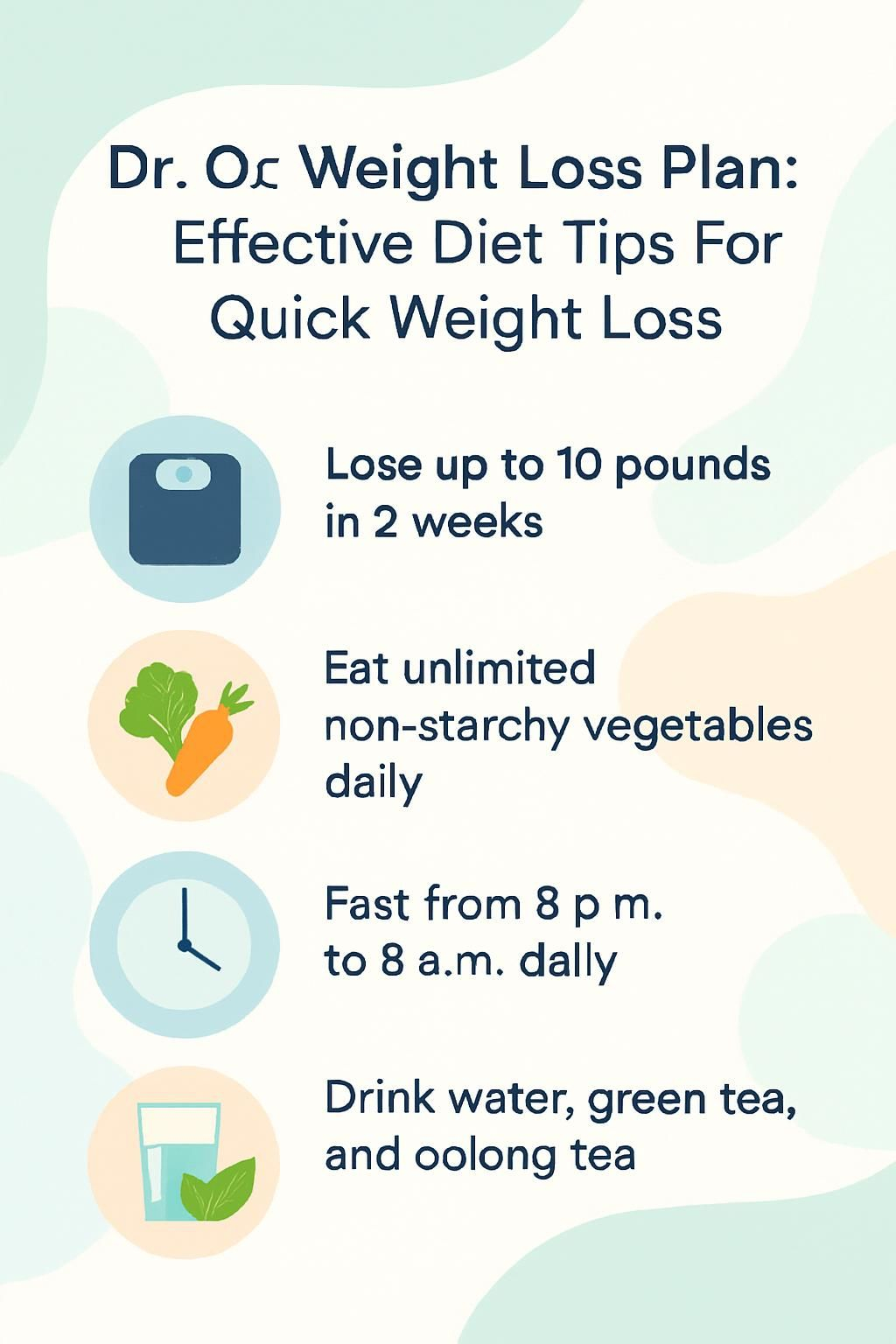Dr. Oz Weight Loss Plan: Effective Diet Tips For Quick Weight Loss
Our Nutrition Assistant AI Suite will transform your body. You will lose fat, get toned, and build muscle. Gain confidence and optimal health.
Losing weight and keeping it off can feel exhausting. The Dr. Oz weight loss plan says you can drop up to 10 pounds in two weeks by choosing whole foods, skipping processed snacks, and cutting sugary drinks. This guide explains Mehmet Oz’s approach, the diet rules, benefits and risks, and how to turn quick results into lasting health.
Key Takeaways
- Dr. Oz’s Total 10 Rapid Weight Loss Plan targets up to 10 pounds in two weeks with a nightly 12-hour fast, no processed foods or sugary drinks, and unlimited non-starchy vegetables.
- The structure includes three meals and two snacks daily, portion guidance without calorie counting, one serving of whole grains, two fruit servings, and limited animal protein.
- The plan promotes water, green tea, and oolong tea. It also mentions supplements like garcinia cambogia and green coffee bean extract, though research shows mixed or limited effects.
- Rapid loss can trigger fatigue, irritability, and rebound weight gain. Strict rules may raise the risk of disordered eating, according to many dietitians and clinicians.
- Experts such as Keri Glassman suggest focusing on sustainable habits, balanced meals, regular exercise, stress control, and 7 to 9 hours of sleep for long-term success.

What Is Dr. Oz’s Philosophy on Weight Loss?

Dr. Oz promotes evidence-based nutrition and simple daily habits. His core message is to control fat gain, support metabolic health, and lower disease risk with smart food choices and steady routines. Small, consistent steps matter more than rare, big efforts.
Dr. Oz’s Total 10 Rapid Weight Loss Plan Overview
This weight loss plan sets clear rules to speed early progress. It combines structure, simple food lists, and a short overnight fast to help you get started quickly.
What Are the Key Diet Principles and Structure?
Fast overnight from 8 p.m. to 8 a.m. That 12-hour break may reduce late-night snacking and help you reset your eating schedule. Eat three meals and two snacks daily with portion guidance, not calorie counting.
Non-starchy vegetables are unlimited, so fill your plate with options like tomatoes, cucumbers, leafy greens, broccoli, and asparagus. Include one serving of whole grains, such as sprouted grain bread, to support steady blood sugar.
The plan includes a daily vegetable broth for hydration and comfort. Some people use Epsom salt baths for relaxation. These practices may help stress relief, though detox claims are not well supported by research.
A daily multivitamin and vitamin D can help close nutrient gaps, especially if your diet is limited. During a two-week trial last spring, sipping green tea between meals helped me feel fuller and steadier in the morning.
Which Foods Should You Eat and Avoid?
Food choices drive results. Focus on whole foods that support heart health, weight management, and lower inflammation.
- Use poultry, fish, or eggs as animal protein, but keep them to two servings per week to encourage plant-based choices.
- Rely on plant proteins such as beans, lentils, tofu, tempeh, and seeds for daily satiety and fiber.
- Include a half avocado each day for monounsaturated fat, which supports heart health and fullness.
- Build smoothies with berries, banana, flaxseed, and unsweetened non-dairy milk to boost nutrients without added sugar.
- Cook with olive oil or coconut oil instead of butter. Olive oil is linked with healthier cholesterol patterns in many studies.
- Snack on apples, berries, and a small handful of nuts. Aim for two fruit servings each day.
- Drink water, green tea, or black coffee. These choices hydrate and may support metabolism.
- Avoid starchy vegetables like potatoes and corn during the two-week phase. Non-starchy options are encouraged.
- Cut refined grains such as white bread and limit ultra-processed foods to reduce insulin spikes.
- Skip added sugars, artificial sweeteners, alcohol, most dairy other than Greek yogurt, butter, and unlisted oils.
Next, you will find practical diet tips that make these rules easier to follow day to day.
What Are the Main Benefits of This Plan?
Eating mostly whole, unprocessed foods can reduce your daily calories without counting each bite. Unlimited non-starchy vegetables add fiber and volume so meals feel larger while staying light.
Healthy fats from olive oil and avocado may help curb hunger. The 12-hour fast can cut late-night snacking, which often leads to extra calories. Plant-forward plans are linked to lower obesity and type 2 diabetes risk, largely due to better blood sugar control.
“I lost five pounds in my first week just by sticking to his shopping list and eating more salads,” shares one patient who followed Oz’s diet plan under physician supervision.
Simple meal rules plus foods like hummus, nuts, lemon, and low-fat dairy add structure without feeling rigid. Many people see early wins on the scale while also improving cholesterol and waist size.
Top Diet Tips from Dr. Oz for Effective Weight Loss
These strategies support safe progress and steady energy. Think of them as guardrails for your weight-loss journey.
How Can You Eliminate Processed Foods and Sugary Drinks?
Processed foods and sugary drinks drive extra calories and cravings. This plan removes white sugar, alcohol, artificial sweeteners, and ultra-processed snacks.
- Read labels and avoid added sugars, hydrogenated oils, and long ingredient lists. Many packaged foods hide sugar in several forms.
- Prep snacks and meals in advance to lower temptation and stick with whole foods.
- Swap soda and energy drinks for water or green tea. Drinking water before meals can reduce calorie intake.
- Clear out refined wheat and white flour products to limit glucose spikes tied to belly fat.
- Choose whole fruit over juice. The fiber in fruit helps you feel full and supports digestion.
- Keep nuts, seeds, fresh vegetables, lean proteins, and avocados on hand for quick, satisfying snacks.
- Track your intake with a journal or app. Self-monitoring boosts weight-loss success.
- Skip drive-thrus. Fast food often contains hidden sugar, salt, and unhealthy fats.
- Join an online support group or follow credible experts who reinforce these habits with science-based tips.
Cutting sugary drinks for one week helped me power through strength sessions and shaved about 200 calories a day without feeling deprived.
How to Increase Fiber Intake with Fruits and Vegetables?
Fiber supports fullness, blood sugar control, and gut health. Plants deliver it best.
- Load up on non-starchy vegetables like broccoli, carrots, spinach, kale, tomatoes, and cucumbers.
- Enjoy two fruit servings daily. Apples and berries are easy, high-fiber picks.
- Blend smoothies with berries, banana, and flaxseed for a mix of soluble and insoluble fiber.
- Sip vegetable broth for fluids and extra vegetables throughout the day.
- Pick plant proteins such as beans, lentils, or tempeh, which add both fiber and protein.
- Add nuts and seeds to salads or snacks. They supply fiber plus minerals like magnesium.
- Choose a colorful mix of vegetables at each meal to boost nutrient density.
- Keep foods close to their natural form to preserve fiber.
- Replace sugary drinks with water or green tea to make room for more fiber-rich foods.
Higher fiber diets are linked with better heart health and lower disease risk. Small daily choices can add up fast.
Why Add Lean Proteins and Healthy Fats to Your Diet?
Protein and healthy fats increase fullness and help you stay on track. They work with fiber to stabilize energy and reduce cravings.
- Lean proteins like poultry, fish, eggs, tofu, tempeh, and beans help meals feel satisfying.
- Dr. Oz limits animal protein to two servings weekly, nudging you toward more plant protein.
- Fatty fish such as salmon offer heart-friendly fats and quality protein.
- A half avocado plus two tablespoons of olive oil per day supports brain and heart health.
- Include nuts, seeds, and nut butters for snacks. They improve satiety and add nutrients.
- Choose low-fat Greek yogurt if you include dairy. It provides probiotics and protein with less sugar.
- Healthy fats and protein help balance blood sugar, which can reduce overeating.
- Plant protein sources are linked with lower heart disease risk in large population studies.
- Adding salmon and tofu to my meals cut afternoon crashes during interval workouts.
- Prioritize whole foods first. Consider supplements only after you dial in meals and activity.
How Does Portion Control Aid Weight Loss?
Portion control limits calories without heavy math. This plan uses three meals and two snacks, with clear serving sizes.
Smaller plates can make servings look larger and help prevent overeating. One serving of whole grains each day, like a slice of sprouted bread, keeps things simple. Batch cooking lets you pre-portion meals, so it is easier to stick to targets.
Research shows smaller portions reduce calorie intake, even without more hunger. Skipping snacks can backfire, leading to cravings. Pre-portioned meals support mindful eating and reduce the risk of a fad diet cycle.
How to Stay Hydrated with Water and Green Tea?
Water is the baseline for hydration and metabolism. Aim for at least eight cups daily, more if active.
Start the day with hot lemon water to set a calm pace. Vegetable broth adds fluids and minerals. The plan allows green tea and morning coffee, plus two cups of oolong tea per day, which some studies associate with modest fat-burning effects.
Avoid sugary drinks, since they raise calories fast. Switching between water and unsweetened green tea kept me full between meals and cut cravings for sweet beverages.
In short, choose water, green tea, vegetable broth, and oolong tea. These drinks support hydration and energy while aligning with the plan’s goals.
How Can Lifestyle Changes Support Weight Loss?
Small daily habits move the needle. Think food, movement, sleep, and stress as four pillars that support results.
What Exercise Routines Complement Weight Loss?
Activity helps you burn calories and protect muscle as you lose weight. A blend of cardio and strength work is ideal.
- Do moderate cardio like brisk walking or cycling for at least 150 minutes per week to support heart health.
- Strength train two or three times weekly with weights or bands to keep muscle and boost metabolic rate.
- Add brief high-intensity intervals. HIIT can reduce belly fat and improve fitness efficiently.
- Pick activities you enjoy, such as swimming, jogging, yoga, or group classes.
- Increase daily movement with stairs, walking breaks, and active errands.
- Stretch after sessions to improve flexibility and reduce soreness.
- Track steps with a wearable or app. Aim for 8,000 to 10,000 steps per day.
- Include core work like planks and dead bugs for posture and trunk strength.
- Hydrate before, during, and after workouts with water or green tea.
This mix burns calories while preserving muscle, which supports long-term weight control.
Why Is Restful Sleep Important for Weight Loss?
Sleep affects hunger hormones. Too little sleep raises ghrelin, which increases hunger, and lowers leptin, which signals fullness.
Adults should target 7 to 9 hours nightly. Quality sleep supports better food choices, steadier metabolism, and mood. Many plans stall due to poor sleep, not just poor meals.
What Are Effective Stress Management Techniques?
Stress can spark emotional eating and belly fat gain. A few daily practices can steady your mind and your meals.
- Practice mindfulness meditation for ten minutes a day to lower cortisol.
- Use deep breathing before meals to slow down and reduce cravings.
- Journal stressful moments and triggers so you can plan better responses.
- Use evening relaxation techniques like progressive muscle relaxation or guided imagery.
- Choose water or green tea over sugary drinks to avoid energy crashes.
- Set regular meal and sleep times to build stability.
- Build social support with friends or groups that share similar goals.
- Discuss magnesium with your clinician if stress and sleep are concerns.
- Use short affirmations each morning to set a positive tone.
- Try quick resets like a 10-minute walk or music break when overwhelmed.
- Subscribe to Dr. Oz’s newsletter for ongoing habit tips and updates.
What Supplements Does Dr. Oz Recommend for Weight Loss?
Some people explore supplements for extra help. Approach them carefully and talk with a healthcare provider first, especially if you take medications.
What Is the Role of Garcinia Cambogia?
Garcinia cambogia contains hydroxycitric acid, which may reduce appetite in theory. Study results are mixed, and reported benefits are usually small compared with diet changes alone.
An often-cited 2011 study found only minimal added loss compared with lifestyle changes. Safety is also a concern for some users. I tried it once and noticed no clear difference beyond what balanced meals already provided.
Use is optional within the Total 10 plan. A clinician’s guidance is important before starting any supplement.
What Are the Benefits of Green Coffee Bean Extract?
Green coffee bean extract contains chlorogenic acids that may influence fat metabolism. Evidence is inconsistent, and quality varies across products.
Dr. Oz has mentioned it as an optional add-on, not a central strategy. Discuss it with your doctor and focus first on food quality, activity, sleep, and stress management. Supplements do not replace core habits.
What Are the Critiques of Dr. Oz’s Weight Loss Strategies?
Many experts question rapid loss claims and the use of supplements with weak evidence. Review current research and speak with your clinician before starting.
What Risks Are Associated with Rapid Weight Loss?
Quick loss can cause irritability, low energy, and stalled progress. Many people regain weight if they return to old habits.
Early pounds often reflect water shifts, not fat loss, which makes rebound common. Strict rules can also raise the risk of disordered eating. In high school, I tried a very low-calorie plan and felt drained. I regained the weight within a month.
Gradual changes tend to support your mind and body better than aggressive short-term tactics. Sustainability beats speed.
Why Is There Debate About the Effectiveness of Supplements?
Garcinia cambogia and green coffee bean extract are controversial. Reviews from reputable institutions have not confirmed strong or consistent effects for weight loss.
Detox ideas like vegetable broth or Epsom salt baths lack strong clinical support. A registered dietitian, Keri Glassman, notes that most people do not need to “detox.” Health professionals usually favor consistent habits over pills and powders.
How Can You Sustain Weight Loss Long-Term?
Long-term success comes from habits you can repeat. Keep what worked, adjust what did not, and plan for busy weeks.
How to Transition to a Well-Balanced Diet?
After two weeks, expand your menu slowly to improve nutrition and reduce the chance of rebound.
- Increase whole grains gradually to meet USDA guidance for your age and sex.
- Reintroduce starchy vegetables like potatoes and corn in modest portions for energy and fiber.
- Add lean animal proteins, such as chicken or fish, two to three times weekly as needed.
- Bring back low-fat dairy slowly to support calcium and bone health.
- Boost fruits and vegetables at each meal for vitamins, minerals, and antioxidants.
- Watch portions as variety grows. Calorie needs depend on age, sex, weight, and activity level.
- Consult a doctor or registered dietitian if you have medical conditions or take medications.
- Track how foods affect energy and digestion. A short journal helped me make smart adjustments.
These steps move you from a short sprint to a steady routine that you can keep for years.
What Are Key Habits for Long-Term Health?
Small, consistent actions protect progress. Use these anchors to prevent backsliding.
- Plan meals and prep on weekends to avoid last-minute takeout.
- Use portion awareness and eat mindfully to reduce overeating.
- Choose whole foods like produce, lean proteins, and healthy fats most of the time.
- Avoid rigid rules that create stress. Flexible structure is easier to keep.
- Drink water throughout the day and add green tea if you enjoy it.
- Exercise at least 150 minutes per week, as the CDC advises.
- Sleep 7 to 9 hours. Good rest supports appetite control and mood.
- Manage stress with breathing, meditation, or supportive conversations.
- Track waist size and other markers, not only the scale.
- Recheck your plan every few months and adjust based on goals and life changes.
These habits support your weight management and your health for the long run.
What Are the Advantages of Dr. Oz’s Weight Loss Plan?
The plan offers simple rules, a clear shopping list, and quick early feedback. Many people like the structure and the focus on real food.
How Does It Improve Health Markers?
Eating fewer refined carbs helps steady blood sugar. Limiting processed foods lowers sodium and unhealthy fats, which can support healthier blood pressure and cholesterol levels. Tea intake may offer modest heart benefits in some studies.
Whole foods and fiber-rich produce support healthy digestion and weight control. People often report steadier energy across the day. These changes can improve blood pressure, cholesterol patterns, and glucose control in the short term and beyond.
How Does It Enhance Metabolic Rate?
High-fiber vegetables and lean proteins can support metabolic health and fullness. Oolong tea may help your body burn calories a bit more efficiently, based on limited evidence. The 12-hour overnight eating window may also cut late snacking.
Removing sugary drinks and processed foods helps regulate insulin, which affects metabolism. Strict portion control helps prevent overeating. While large metabolic boosts are unlikely, these steps support a stable, responsive metabolism.
How Does It Reduce Abdominal Fat?
This plan aims to reduce central fat with portion control, higher fiber, and fewer refined carbs. Lean protein, vegetables, and healthy fats help cut visceral fat, which surrounds organs and raises health risks.
Reducing added sugars and refined grains can limit insulin spikes that store belly fat. Routine exercise, even brisk walking, helps shrink waist size. For context, many guidelines use less than 35 inches for women and less than 40 inches for men as healthier waist targets.
One patient reported a looser waistband within weeks after switching to whole foods. Diets rich in whole foods are linked with lower rates of central obesity in several studies.
Conclusion
The Dr. Oz weight loss plan can jumpstart progress with whole foods, higher fiber, and clear structure. Add consistent exercise, hydration, sleep, and stress control to protect your results.
Some rapid results and supplement claims lack strong scientific support. Talk with a healthcare provider, especially if you have medical conditions or take medications. Use this diet as a short kickoff, then shift to balanced, sustainable habits that fit your life and support long-term health and weight management.
FAQs
1. What is the main idea behind the Dr. Oz Weight Loss Plan?
The Dr. Oz Weight Loss Plan focuses on balanced nutrition, portion control, and regular physical activity. It encourages eating whole foods, lean proteins, fruits, and vegetables. Research supports these habits for effective and sustainable weight loss.
2. Are there specific foods recommended in the Dr. Oz Weight Loss Plan?
Yes, the plan highlights foods like leafy greens, berries, skinless poultry, and whole grains. These foods are low in calories but high in nutrients. Studies show that eating these can help reduce calorie intake while providing essential vitamins and minerals.
3. How quickly can someone expect to lose weight on this plan?
Weight loss rates vary based on individual factors such as age, activity level, and starting weight. Most people can expect to lose one to two pounds per week with consistent effort. Clinical data suggests this rate is safe and more likely to lead to long-term results.
4. Does the Dr. Oz Weight Loss Plan include exercise recommendations?
The plan encourages regular movement such as brisk walking or cycling for at least 30 minutes most days of the week. Physical activity helps burn extra calories and supports heart health. Personal experience shows that combining exercise with diet changes improves results and boosts motivation.
Summary:
The Dr. Oz Weight Loss Plan uses evidence-based diet tips for quick weight loss by focusing on nutritious foods and regular exercise. The plan recommends gradual weight loss for lasting success and includes practical steps supported by research.







